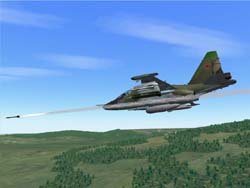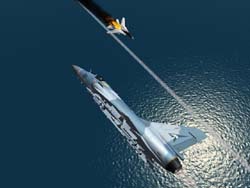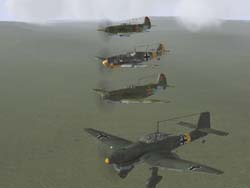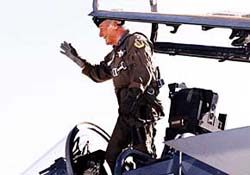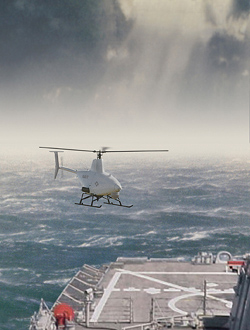Page 1
Daily News
By Gail Helmer
| Send Us News | Archives | Main |
Monday August 19, 2002
PC News
- Armored Task Force Demo
- New Screens: LO:MAC
- IL-2 Sturmovik v1.2 Announcement
- Panzer Elite Patch v1.2
- New Screens: America's Army
- Yeager To Give Up Military Flying After October Airshow
- Fire Scout Demonstrates Payload Capabilities
Armored Task Force Demo
ProSIM has released a Armored Task Force demo. This demo version contains two scenarios set in Death Valley, California. This is the final build of the game, with all of the friendly and enemy AI layers complete. The intent is to let you see some of the innovative new features that will be in final release.
Armored Task Force will feature fixed-wing and rotary-wing aviation, mine-layers, laser observers, and tons of other unit capabilities. Also, there are tons of scenarios and maps, packed into three campaigns, in Iraq, NTC at Ft. Irwin, and the Fulda Gap. The final release also includes a full-featured scenario editor. Check out the demo version today. Download
New Screens: LO:MAC
Check out these new screens from Ubi Soft's upcoming jet simulation, Lock On: Modern Air Combat.
SU-39 Launching An Anti-Tank Missile
Mirage 2000 downing a Tomcat
IL-2 Sturmovik v1.2 Announcement
Ubi Soft Entertainment will release an upgrade for IL-2 Sturmovik. The IL2-Sturmovik version 1.2 upgrade includes four new flyable aircraft including theYak-9, Yak-9D, Bf-109-E-7/NZ and Ju-87B-2, and features 10 new single player missions and six new cooperative online missions for the IL-2 community. Version 1.2 will be available for download in three weeks from the official IL-2 Sturmovik website.
The new aircraft in IL-2 Sturmovik v1.2
Panzer Elite Patch v1.2
Wings Simulations has issued a new patch for Panzer Elite, upgrading their 3D tank simulation set in World War II to version 1.2. This release addresses joystick issues, makes multiplayer work under Windows XP and 2000, and applies some other fixes. Download
New Screens: America's Army
We have some new screens from the upcoming Airborne School pack for America's Army. No details on the upcoming pack are available, but we will keep you posted.
Military News
Yeager To Give Up Military Flying After October Airshow
Aviation legend retired Brig. Gen. Chuck Yeager visited Edwards Aug. 12 and 13 to chat with airmen around the base and to prepare for his opening flight at the Edwards 2002 Open House and Air Show Oct. 26.
This September, Yeager will have been flying military aircraft for more than 60 years. During his most recent visit, Yeager said there was no better way to mark the occasion than by kicking off this year's open house in an F-15 Eagle along with his long-time friend and colleague retired Maj. Gen. Joe Engle.
"It's very unusual that we can still do the opening together," said Yeager. "But the Air Force and the Flight Test Center have given us the opportunity and we are taking advantage of it."
Reflecting on his 60 years of flying, Yeager said he has been "very, very lucky" in being afforded the opportunity to fly military aircraft for six decades. After retiring from the Air Force with more than 34 years of service, including in World War II and Vietnam, he continued flying as a consultant test pilot here, logging time in the F-15 and the F-16 Falcon as well as other aircraft.
However, it appears Yeager's time flying military aircraft may be coming to a close after his approaching open house mission.
"I have decided that during the open house and airshow I'll make a sonic boom in the F-15, but sixty years is long enough for me to be flying military airplanes," Yeager said.
The retired general is quick to point out that he is not giving up flying all together. He plans to continue flying P-51 Mustangs and various light aircraft.
Yeager said this year's open house is especially important in light of last year's tragic events and feels the public is ready to once again see what the Air Force has to offer.
"People always love to come out to Edwards because they can see some very exotic airplanes," he said. "It's good to see people bring their kids, and there is nowhere in the world can you hear a sonic boom like they will hear here."
Maj. Gen. Doug Pearson, commander of the Air Force Flight Test Center, said there is no doubt that the flight test legend will be a great crowd pleaser this October.
"He ties our past with our future," Pearson said. "General Yeager is such a piece of our heritage here at Edwards, but yet he is so much into our future and very much in touch with what we are doing here today."
Pearson said that the entire base is pulling together to ensure a successful air show for all those heading to Edwards in October.
"We are looking forward to showing the public our current state-of-the-art military capabilities," he said. "That is really what this airshow is all about."
Fans of the flight test legend can look for him to return to Edwards for the official opening of the Open House and Air Show in October.
Fire Scout Demonstrates Payload Capabilities
Northrop Grumman Corporation's Integrated Systems sector today successfully conducted the first inflight sensor payload demonstration of the U.S. Navy's RQ-8A Fire Scout vertical takeoff and landing tactical unmanned air vehicle system at Naval Air Weapons Station, China Lake, Calif.
The Fire Scout system is in development and low-rate initial production by Northrop Grumman as a force multiplier for Navy forces at sea and Marine Corps forces ashore.
The Fire Scout payload, which is supplied by Northrop Grumman's Electronic Systems sector, Baltimore, Md., consists of electro-optical and infrared sensors and a laser designator/rangefinder, which provide intelligence, surveillance and reconnaissance imagery and data.
As in previous Fire Scout flight tests, the preprogrammed autonomous mission included vertical takeoff, accurate navigation and return to a predetermined hover point in preparation for landing-all without operator intervention. In today's test, the Fire Scout flew for 30 minutes through 16 waypoints at the China Lake range. Using both the electro-optical and infrared sensors, Fire Scout located, identified and tracked a mix of targets including vehicles, buildings and geographic features. In addition, it employed the laser rangefinder to evaluate the precision target location feature of the payload and vehicle management system. During the flight, the vehicle climbed to a maximum altitude of 4,000 feet at an air speed of 100 knots. The ongoing flight series includes a number of important tests and has demonstrated the system's ability to take off, fly, navigate and land autonomously and collect imagery from its onboard sensor payload. Additional flight tests to support engineering and manufacturing development are planned this fall. Flight tests to demonstrate weapons targeting and delivery as well as shipboard landings are also being considered.
The Fire Scout system is in development for the Navy and Marine Corps. Flying at altitudes up to 20,000 feet, it employs an advanced payload with an electro-optical/ infrared sensor including a laser designator/rangefinder to provide intelligence, reconnaissance and surveillance with pinpoint accuracy. This demonstrated system provides military decision-makers real-time information and targeting of enemy resources and personnel on the ground. The Fire Scout's communications suite allows simultaneous voice/data relay much farther than the "line of sight" limits of current systems.
Fully autonomous, Fire Scout can fly high above deployed Marines to watch for threats within 150 nautical miles of the ground control station. The system then directs Navy and Marine weapons accurately to the target with precise target location coordinates or the laser designator. Fire Scout was designed to respond to Navy and Marine Corps emerging requirements and to replace the aging Pioneer. A complete system includes three UAVs, two ground control stations, a datalink suite and modular mission payloads.
| Send Us News | Archives | Main |
